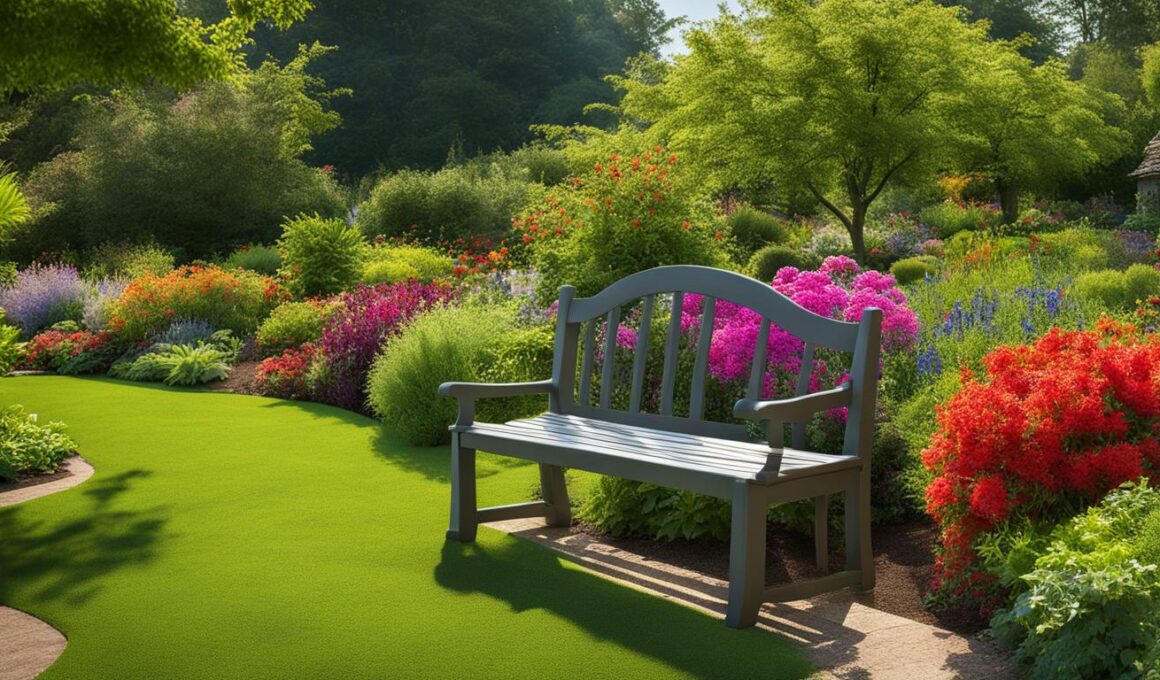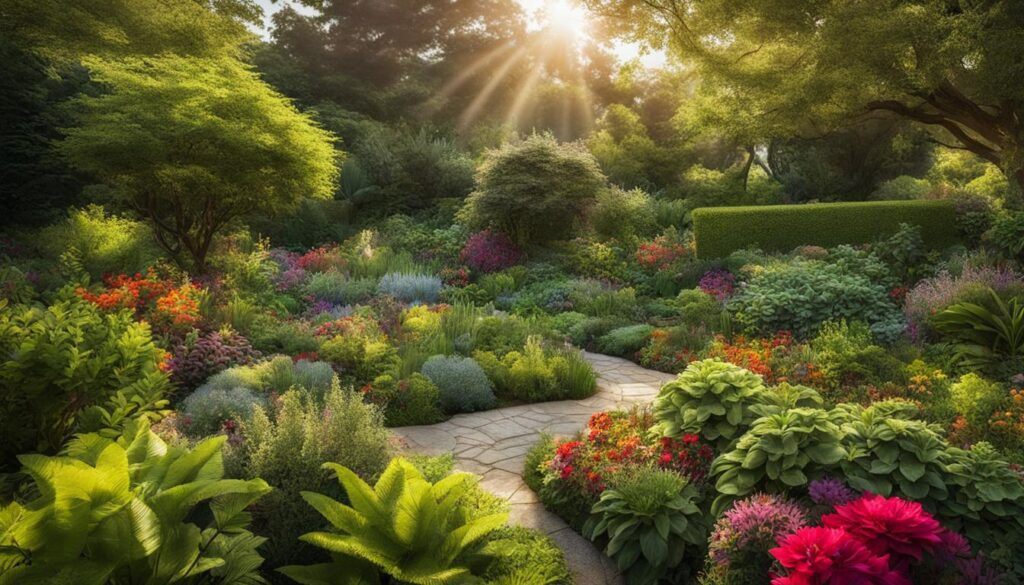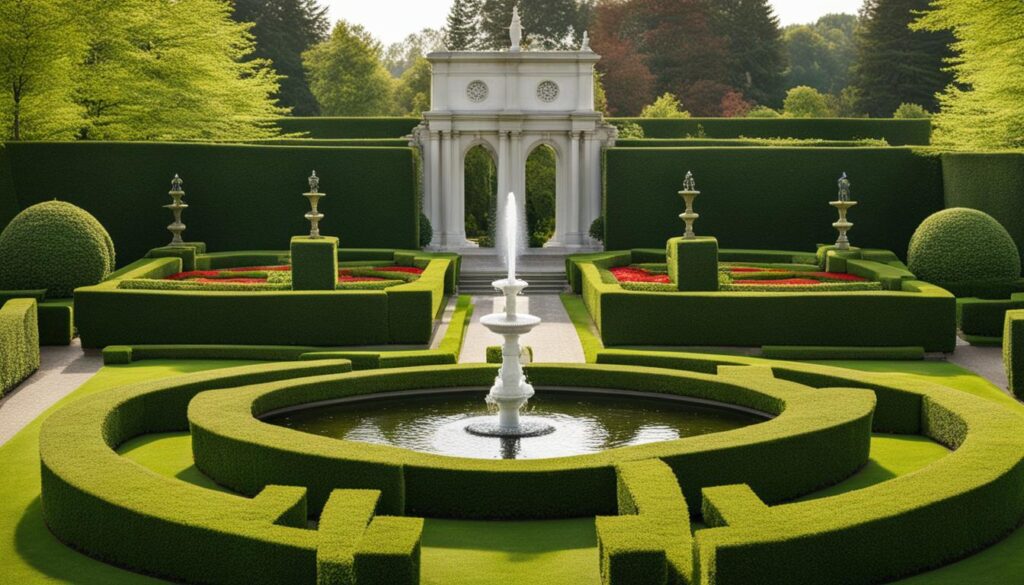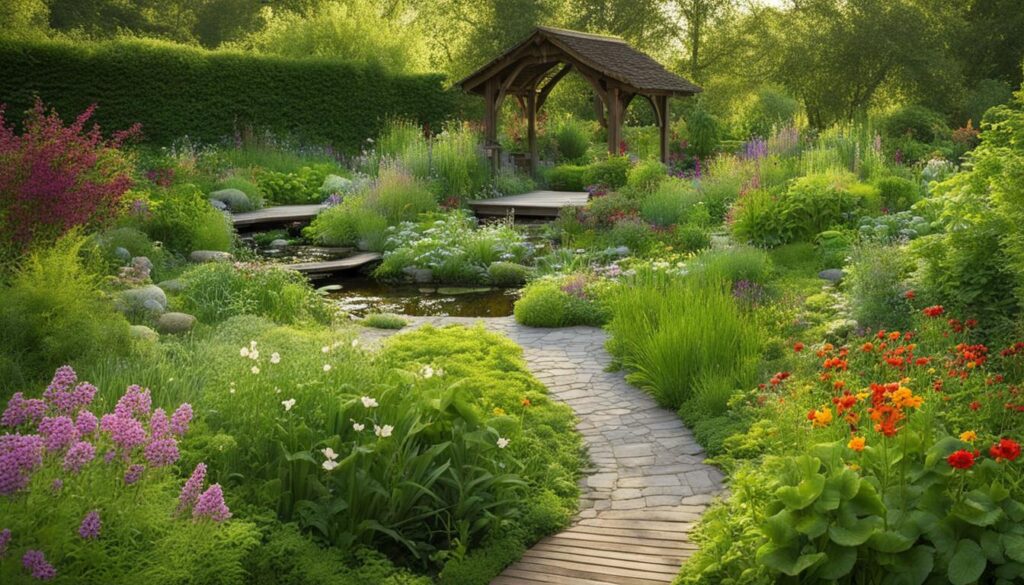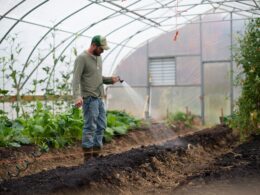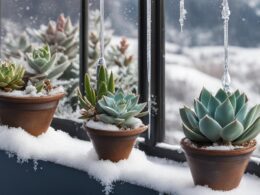Investing in trees, shrubs, flowers, and other plants is a worthwhile investment as it increases property value by 5.5%-12.7% and adds beauty to your yard. Plants also have numerous mental health benefits, such as boosting immune systems, reducing stress, and improving focus. They provide privacy, attract birds and wildlife, control erosion, and offer environmental benefits like producing oxygen and stabilizing the water cycle. Surrounding yourself with trees and plants is not only visually appealing but also beneficial for the environment.
Key Takeaways:
- Garden must-haves like trees, shrubs, flowers, and plants can increase property value and add beauty to your yard.
- Plants have numerous mental health benefits, including reducing stress and improving focus.
- They attract birds and wildlife, control erosion, and provide privacy.
- Plants offer environmental benefits by producing oxygen and stabilizing the water cycle.
- Incorporating trees and plants is not only visually appealing but also beneficial for the environment.
The Benefits of Landscaping with Plants
Landscaping with plants offers numerous benefits for your yard and overall well-being. Not only does it enhance the beauty of your outdoor space, but it also increases the value of your property. By incorporating various plants, you can create an inviting and visually appealing landscape that will leave a lasting impression on visitors and potential buyers. Research shows that landscaping can increase property value by 5.5%-12.7%, making it a worthwhile investment for homeowners.
Aside from the financial advantages, landscaping with plants also provides mental health benefits. Spending time in nature has been proven to reduce stress, boost immune systems, and improve focus. By surrounding yourself with trees, shrubs, flowers, and other plants, you can create a peaceful and calming environment that promotes relaxation and well-being.
“Landscaping with plants not only enhances the visual appeal of your yard but also contributes to a greener lifestyle. Plants attract birds, butterflies, and other wildlife, creating a vibrant ecosystem. They also help control erosion, improve soil stability, and contribute to environmental benefits such as oxygen production and water cycle regulation.”
Furthermore, landscaping with plants has significant environmental benefits. Plants absorb carbon dioxide and produce oxygen, contributing to cleaner air. They also help regulate the water cycle by reducing runoff and soil erosion. By incorporating a variety of plants in your landscape, you can create a diverse ecosystem that supports biodiversity and helps preserve the natural environment.
Creating a Sustainable Landscape
To maximize the benefits of landscaping with plants, consider incorporating sustainable practices in your garden design. This includes using native plants that are well-suited to your climate and require minimal water and maintenance. By choosing plants that are adapted to the local environment, you can conserve water resources and reduce the need for fertilizers and pesticides.
- Plant native flowers and shrubs that attract pollinators like bees and butterflies.
- Include a variety of plant species to provide food and habitat for wildlife.
- Use organic mulch to suppress weeds, retain moisture, and improve soil health.
- Consider installing a rainwater harvesting system to collect and reuse water for irrigation.
By implementing these sustainable practices, you can create a beautiful and eco-friendly landscape that benefits both you and the environment.
Choosing Garden Styles – Formal vs. Informal
When it comes to landscape design, selecting the right garden style is key to creating a visually appealing and cohesive outdoor space. Two popular options to consider are formal gardens and informal gardens. Each style offers a unique aesthetic and has its own set of characteristics.
Formal Gardens
Formal gardens are known for their structured and symmetrical designs. They often feature geometric shapes, clean lines, and precise plant spacing. The layout and color scheme of formal gardens are carefully planned to create a polished and manicured look.
Formal gardens are an excellent choice for homeowners who prefer a more traditional and refined landscape. They lend a sense of elegance and sophistication to any property. The precise arrangement of plants in formal gardens showcases a meticulous attention to detail.
Informal Gardens
If you prefer a more relaxed and natural look, an informal garden might be the perfect choice for your landscape design. Informal gardens embrace free-flowing forms and organic shapes, creating a more relaxed and casual atmosphere.
Informal gardens offer a sense of whimsy and informality, making them a popular choice for many homeowners. These gardens often mimic natural landscapes and are characterized by a mix of different plants and a more relaxed planting style.
When deciding between formal and informal gardens, consider your own personal style preferences and the overall aesthetics of your property. Both garden styles can create stunning outdoor spaces, and the choice ultimately depends on the look and feel you want to achieve.
Creating Beautiful Flower Beds – Border vs. Island
Flower beds play a crucial role in adding color, texture, and visual interest to your garden. When designing your flower beds, you have two main styles to choose from: border flower beds and island flower beds. Each style offers its own unique aesthetic appeal and planting considerations.
Border Flower Beds
Border flower beds are typically placed against a backdrop such as a porch, fence, or house wall. They provide a defined edge to your garden and create a structured and organized look. When designing a border flower bed, it’s important to consider the height, groupings, and spacing of the plants. Typically, taller plants are placed at the back, medium-sized plants in the middle, and shorter plants at the front to create a visually pleasing layering effect. This style is ideal for creating a tidy and formal look in your garden.
Island Flower Beds
Unlike border flower beds, island flower beds are not anchored by a backdrop and can be viewed from all sides. They have a more free-flowing and organic shape, offering a natural and relaxed look to your garden. When designing an island flower bed, focus on creating a central point of interest with taller plants, gradually transitioning to shorter plants towards the edge of the bed. This style allows for more creativity and flexibility in terms of plant placement and offers a more informal and casual vibe.
When planting your flower beds, consider the overall theme and visual harmony you want to achieve in your garden. You can mix and match different styles and experiment with various plant combinations. Remember to select plants that thrive in your specific climate and provide proper care and maintenance for healthy and vibrant flower beds. Whether you choose border flower beds for a structured look or island flower beds for a more organic feel, creating beautiful flower beds will add charm and beauty to your garden.
Getting Started with Your Garden – Preparation and Planting
Starting a garden is an exciting endeavor that allows you to connect with nature and create a beautiful outdoor space. Whether you’re a beginner or an experienced gardener, proper preparation and planting techniques are essential for success. Here are some tips to help you get started:
1. Choose the Right Location
Before you begin, carefully select the location for your garden. Consider the sunlight requirements of the plants you want to grow and choose a spot that receives adequate sunlight throughout the day. Additionally, ensure easy access to a water source for irrigation purposes.
2. Prepare the Soil
Preparing the soil is crucial for healthy plant growth. Start by removing any weeds or sod from the area. You can also opt for the lasagna gardening method, which involves layering organic materials like cardboard, compost, and soil to create nutrient-rich soil. Test your soil’s pH level and add organic matter, such as compost or aged manure, to improve its quality.
3. Selecting Plants
When selecting plants for your garden, consider factors like your climate, soil conditions, and personal preferences. Explore different varieties of flowers, vegetables, herbs, and shrubs that thrive in your region. Decide whether you want to start your garden from seeds or opt for young plants for transplanting.
4. Planting Tips and Techniques
When planting, follow the recommended spacing guidelines for each plant to ensure adequate room for growth. Dig holes that are slightly larger than the plant’s root ball and gently loosen the roots before placing the plant. Water your plants regularly, providing enough moisture without overwatering. Consider using supports like stakes or trellises for climbing plants or vegetables.
Remember to keep up with garden chores such as weeding, pruning, and harvesting to maintain a healthy garden. Keep a garden calendar to track important dates and tasks, ensuring you are on top of planting and maintenance activities throughout the year.
With these tips and techniques, you’ll be well on your way to creating a thriving garden that brings beauty and joy to your outdoor space.
Tips for Maximizing Your Garden’s Potential
To make the most of your garden and create a stunning outdoor space, consider the following tips and techniques:
1. Thoughtful Garden Design
Maximize your garden’s potential by implementing thoughtful design techniques. Create depth and visual interest by layering plants of different heights, with taller ones at the back and shorter ones in the front. Utilize all available space by planting vertically with hanging baskets or trellises. Consider incorporating arbors and picket fences for a charming cottage-style look. These design elements will transform your garden into a visually appealing and inviting space.
2. Tool Maintenance
Keep your garden tools in top shape to ensure efficient use and long-lasting durability. Regularly clean and oil your tools to prevent rust and maintain their effectiveness. Sharpen blades on pruning shears, hedge trimmers, and lawnmowers to achieve clean cuts and healthy plant growth. By taking care of your tools, you’ll make gardening tasks easier and more enjoyable.
3. Attracting Butterflies and Enhancing Biodiversity
Invite an array of beautiful butterflies into your garden by planting nectar-rich flowers that bloom for extended periods. Opt for varieties such as milkweed, butterfly bush, and coneflowers. These vibrant blooms will not only attract butterflies but also contribute to the overall health and biodiversity in your garden. Create a diverse garden by incorporating different types of plants, including native species, to support beneficial insects and wildlife.
By following these tips, you can maximize your garden’s potential and create a space that is not only visually stunning but also attracts beneficial wildlife. Incorporate thoughtful garden design, maintain your tools, and embrace a diversity of plants to create a flourishing and enchanting outdoor sanctuary.
Conclusion
By incorporating garden must haves like trees, shrubs, flowers, and various plants, you can create a beautiful yard that enhances the overall aesthetic and increases the value of your property. Not only will your yard be visually appealing, but it will also provide numerous mental health benefits, such as reducing stress and improving focus. By attracting birds and wildlife, your garden becomes a vibrant ecosystem that brings life and joy.
Embracing a greener lifestyle is essential in today’s world, and having a diverse range of plants in your yard is a significant step towards that. Trees and plants offer environmental benefits like producing oxygen and stabilizing the water cycle, which helps in conserving and preserving our planet. By choosing a variety of plants, you create a garden that is not only visually captivating but also contributes to the diversity and health of our ecosystem.
Understanding different garden styles and flower bed designs allows you to create a cohesive and harmonious landscape. Whether you prefer the structured and elegant look of a formal garden or the relaxed and natural feel of an informal garden, your choice should reflect your personal taste and complement the overall aesthetics of your property.
With proper preparation and planting techniques, you can maximize your garden’s potential and enjoy its beauty throughout the seasons. Consider the sunlight requirements and water accessibility when selecting the ideal location for your garden. Prepare the soil by removing weeds, testing its quality, and adding organic matter. Choose between starting from seeds or buying young plants for transplanting based on the type of plant you want to grow. Finally, stay consistent with watering, weeding, and maintenance tasks to ensure your garden thrives.
What Garden Must Haves Can Enhance the Use of Trellis Netting in Your Yard?
When looking for trellis netting garden ideas, consider adding essential garden must-haves like sturdy posts, zip ties, and durable plants. These items can help enhance the use of trellis netting in your yard, providing support for climbing plants and creating a visually appealing garden space.
FAQ
What are the benefits of landscaping with plants?
Landscaping with plants can increase property value, provide mental health benefits, attract birds and wildlife, control erosion, and offer environmental benefits like producing oxygen and stabilizing the water cycle.
What are the different garden styles to choose from?
There are two main garden styles to choose from: formal gardens, which have a manicured and clean look with geometric shapes; and informal gardens, which have a more relaxed and natural look with free-flowing forms.
How should I design my flower beds?
Border flower beds should have taller plants at the back, medium-sized plants in the middle, and short plants in the front. Island flower beds should have taller plants in the middle and shorter plants towards the edge.
How do I start a garden?
Choose the right location based on sunlight requirements and easy access to water. Prepare the soil by getting rid of weeds and improving its quality. Decide whether to start from seeds or buy young plants. Water regularly and stay on top of maintenance tasks.
How can I maximize my garden’s potential?
Use design techniques like layering plants of different heights, keep your tools sharp, attract butterflies with long-blooming flowers, create a diverse garden with a wide variety of plants, and consider implementing cottage-style elements.
What are some essential garden must haves?
Trees, shrubs, flowers, and various plants are essential garden elements that can create a beautiful yard, increase property value, provide mental health benefits, attract birds and wildlife, and offer environmental benefits.





